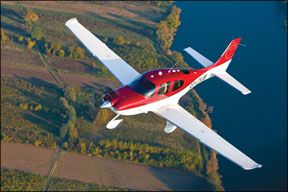The Cinderella general aviation success story of the 2000s must be Cirrus aircraft in general, and the SR22 specifically. Since the company first morphed from a quirky kit supplier to a full-blown aircraft manufacturer in 1998, it has consistently proven that it got the vision thing right. The SR20 and SR22 in their various Photo by Andrzej Rutkowski/Przeglad Lotniczy iterations have proven hot sellers and good performers, with unusually loyal customers. What explains it? We think there are several reasons. The airplanes perform we’ll and generally deliver on the claim of being easy to fly for people new to the aviation game. Moreover, they offer the right combination of cutting-edge equipment and construction methods without becoming so weird or quirky that buyers are put off. The whole-plane parachute, which Cirrus pioneered as a signature marketing feature, has been a factor. In a poll we conducted shortly after the SR22 appeared, we asked if the parachute was a driver in the purchase decision. Only a third of respondents said it was, but we think that understates the case. Perhaps the parachute is the pot sweetener that pushes buyers considering something else into the Cirrus camp. “The parachute is what sells the wife on the airplane,” one commenter said. 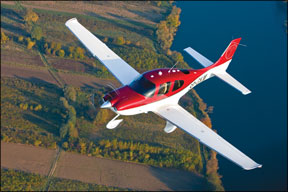
Among homebuilders, Cirrus was well-known during the 1990s for its VK30 pusher kit, an innovative composite design that gained some traction but wasnt a major player in the field. By the mid-1990s, Cirrus principles Alan and Dale Klapmeier developed a new vision, reasoning that the time was right for a high-performance, composite fixed-gear single that anyone could fly.
On a variation of Cessnas famed “drive it up and drive it down” campaign of the 1970s, the Klapmeiers launched the company on the premise that it didnt take special DNA to be a pilot. Anyone could do it with the right airplane. And if you got over your head, you wouldnt have to die for your mistake; the BRS parachute would pull your fat out of the fire.
The companys first product was the SR20, which appeared in 1999, powered by a 200-HP Continental IO-360ES. At about $197,000 equipped, the airplane was a good buy and proved a strong seller. It also gave buyers their first look at largescreen displays in an aircraft, ARNAVs ICDS 2000. By modern standards, this would barely rise to the level of rudimentary, but a decade ago, it did the job, even if the display wasnt as impressive as the Garmin GNS430s that drove it.
But going in, Cirrus knew what Cessna, Piper, Beech and others have always known: If you don’t have a follow-on model, your success will be shortlived.
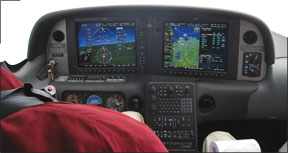
Two years later, for the 2001 model year, Cirrus announced the SR22 step-up model and immediately hit pay dirt. Although the SR20 was no slouch, its 150-ish cruise and limited payload left some buyers wanting.
The SR22 scratched that itch. It had a 310-HP Continental IO-500-N, one of Continentals best-ever powerplants, a three-blade prop and more payload, although the basic airframe is largely the same.
The IO-550-N brought some improvement to the front end. Its smoother, a bit more economical and doesnt have the altitude-compensating fuel pump that can be a maintenance nuisance in the SR20s.
Cirrus pioneered the two-lever control so the SR22 has a throttle and mixture lever, but no prop control. The RPM is handled by a cable-and-cam arrangement that sets the RPM at either 2700 RPM for takeoff or 2500 RPM for cruise. Most owners seem to like this arrangement, but for those accustomed to three levers, it takes some getting used to.
The SR22 airframe is slightly different than the SR20. The wingtips are 18 inches longer, the rear elevator is larger and the landing gear was moved inboard to give more ground clearance for the prop. Although identical in section to the SR20, the SR22s main spar is substantially beefed up and accommodates more fuel, 84 gallons in the SR22 compared to 60 gallons in the SR20. The SR22s energy absorbing seats were modified to account for the airplanes higher weight.
Speaking of weight, the SR22s gross is obviously higher and so is its payload. When we flew one of the first factory demos in 2001, the aircraft had an 1152-pound useful load or 648 pounds with full fuel on a 3400-pound gross. When the SR22 appeared, Cirrus had just certified a 100-pound upgrade for the SR20, giving it a 3000-pound gross weight with a useful load of about 1030. On equivalent fuel, the SR22 enjoys a 120-pound advantage. Were told by most owners, however, that the SR22 is typically flown with one or two people aboard, full fuel and all the baggage you want.
The SR22 will blister along at 170 to 180 knots on about 18 GPH rich of peak. But not many owners run the airplanes that way, given the reality of $5 avgas. Throttling back to 65 percent on the lean side gives about 15 GPH and 172 knots. You can easily push that up to 80 percent power on 17 GPH and recover some of the lost speed. This appears to be where most owners operate the SR22. The IO-550 is smooth and perfectly happy in this regime. It will run even leaner for max-range cruise.
The 17 GPH setting yields about four hours of endurance for a still-air range of 700 miles, with reserves. At the max range setting, 1000 miles is doable.
Along with Diamond, Cirrus pioneered high-volume composite construction for light aircraft. When this technology was on the horizon, the aviation press was allowed to believe it would be stronger, lighter and cheaper than metal, even if Cirrus didnt say that exactly. Well, it did say stronger and the Cirrus airframe demonstrably meets this claim, according to static structural tests. Cirrus did full-scale crash testing of prototype fuselages at NASAs Langley, Virginia, facility that revealed that even at high impact loads, the composite fuselages remain relatively
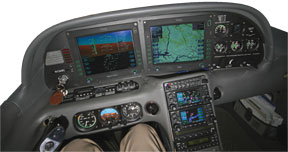
intact.
The fuselages are laid up in molds in two halves, with the two shells joined and then cured in an autoclave. The wings are similarly constructed and are of a single-piece built around and bonded to a massive spar. This forms a strong torsion box that has proven we’ll in the rigors of real life service. But unlike Cessnas and Diamonds, de-winging is a challenge, given the single-piece structure. Control surfaces are conventional riveted aluminum, with a combination of push-pull tubes, cables and bellcranks and a sidestick controller rather than a yoke or center stick. Most of the control circuitry lives under the floorboards, where its accessible via generous inspection panels.
As with the SR20, trim is entirely electric via a single coolie hat on the side controller, fore and aft for pitch, side-to-side for aileron. A few, early SR22s also had electric rudder trim, but that was later deemed unnecessary. Because the pitch trim motor is aggressive, mastering smooth pitch trim changes requires a deft touch to avoid bobbles. We wouldnt mind a slower turning servo motor or even manual trim with an old-fashioned wheel. But that goes against the grain these days.
Thats also true of the SR22s nosegear and main gear system. It has a castering nosewheel and steering is via differential braking, the weight-saving design philosophy that every major manufacturer seems to follow these days. This works we’ll enough in the real world, but has the downside of chewing up brake pads and, in the case of the SR22, leading to several brake-induced fires. This led to an AD requiring periodic O-ring replacement and a brake temperature inspection hole. Some owners say brake wear isn’t an issue if you stay off the binders during taxi.
The wing section and planform is uniquely composed of varying sections, thus the leading edge has the characteristic split on the outer panels. Because the outer panels have a lower angle of incidence, they remain flying while the inner sections have stalled, improving control through the stall and theoretically adding spin resistance. The Cirrus aircraft arent approved for spins and in place of proving spin recovery, the BRS parachute is provided as the equivalent level of safety.
The fuel system in the SR22 consists of wet cells in each wing. These are plumbed to a single tank switch located on a console between the two pilot seats, which is in plain view and situated near the fuel level gauges. Although the fuel is relatively well-protected in the wings, it appears to be not as we’ll protected as in other aircraft, specifically the Diamond line. Our review of accidents reveals a higher incidence of post-crash fire in the SR22 than in Diamond aircraft.
In keeping with its new-age approach to safety, Cirrus ridded its models of vacuum instrument systems as soon as it could. Although the early SR20s had vacuum pumps and later became all-electric, SR22s were all-electric right out of the blocks. It has two alternators and two batteries, each electrically isolated from the other and either capable of powering essential electrics. The main alternator is 60 amps, the secondary is 20 amps while the main or starting battery is 10 amp hours. The secondary is composed of two smaller 12-volt batteries connected in series.
As do transport aircraft, the SR22 has more than a single electric bus; two in fact, a main and an essential that, in the event of a battery/alternator failure, will power sufficient avionics to continue the flight. Either alternator can power the essential bus.
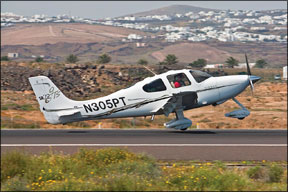
On the downside, both alternators are gear driven, one on the front of the engine and one on the rear accessory case. Given the service history of Continental alternators, our druther is to have one belt driven. In any case, we think the all-electric airplane is a significant advance over anything to do with vacuum instruments, which owners have tolerated for years because there was no choice.
The two models share the same CAPS ballistic parachute but with its 3400-pound gross weight, the SR22 can be up to 500 pounds heavier. That means descent under canopy could be as high as 28 feet per second compared to the 24 feet per second typical for the SR20. Thats a vertical descent of 1680 FPM/19 MPH versus 1440 FPM/16 MPH. Cirrus has said it and we’ll say it again: A ride to touchdown under the CAPS canopy wont be something you’ll want to repeat, although the vast majority of real-world deployments have yielded no or minor injuries.
Buying a used SR22 is not like buying an older Cessna 182 or a Saratoga. Thats mainly because you wont see much post-factory equipment variation on Cirrus aircraft. They emerged from the factory fully formed and the panels don’t allow many options to mix and match, although some of the early steam gauge airplanes are getting Aspen Evolution systems or were converted to Avidyne glass.
The original SR22s had an “A” and “B” option list. The A airplanes, which retailed for $276,600, had a Garmin GNS430/420 combination, and S-TEC System 30 autopilot and a Century NSD-1000 electric HSI. The B airplanes ($294,700 retail) had dual GNS430s, a System 55 autopilot, and a Sandel 3308 color HSI. Both options had the ARNAV ICDS-2000 color MFD. The only other option in the early airplane was a WX-500 Stormscope and, later, the Goodrich Skywatch system. At the time, we liked the panel but predicted the ICDS-2000 wouldnt be long for the airplane.
We were right. Within a year the ICDS-2000 was replaced by the Avidyne FlightMax MFD and most of the early aircraft have been converted. By the 2003 model year, SR22s with full Avidynes Entegra PFD/MFD glass cockpits found their way into customer hands. The Avidyne airplanes had GNS430s, a System 55 and Avidynes E-max engine monitoring. TKS was available as an option in the earliest SR22s, but it wasnt approved for known icing. That option didnt appear until 2009.
In the 2004 model year, the SR22-G2 emerged, which featured a redesigned cowl, a new prop, a spiffed up interior, an improved door latch design and a six-point engine mount that addressed vibration issues in the first SR22s.
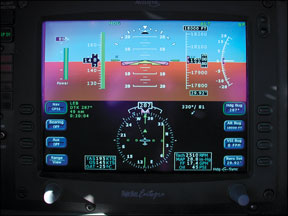
Early on, Cirrus discovered something unique about its buyers: A substantial number of them would replace a recent model SR22 if a newer model had noticeable improvements. We know of many Cirrus owners who have bought two or three new airplanes in the space of five years or less.
Not one to let this opportunity pass by, Cirrus rolled out one of its best sellers ever in the form of the turbonormalized SR22 for the 2007 model year. Cirrus had heard its customers ask for a turbocharged SR22 and Dale Klapmeier told us the company had considered it from early on. Unfortunately, Cirrus couldnt get its in-house developed turbo to run cool enough, so it never brought the product to market.
To address the demand, it did something unusual: It contracted with Tornado Alley Turbo to install a turbonomalized system under STC. These airplanes proved so popular that for a time, they outsold the normally aspirated version by a margin of two to one. Many owners traded up to the turbo model.
Some of them traded up again a year later when Cirrus announced the G3 model with several improvements, including a redesigned wing with 92 gallons fuel capacity and a carbon fiber spar, the removal of the aileron-rudder interconnect found on earlier models and improved environmental and interior options.
Hot on the G3s trail the next year was the Perspective model, a version with the Garmin G1000 EFIS suite adapted specifically to the Cirrus including synthetic vision, a flight director and the GFC700 autopilot with a unique save-my-bacon button that, when pushed, automatically returned the aircraft to wings-level flight. Perspective-equipped airplanes soon displaced the Entegra, which was showing its age, though there was a slight weight penalty for the Perspective models.
Even as aircraft sales hit the skids in 2008 and 2009, Cirrus continued to introduce improvements to the SR22. In 2009, it began offering a known-icing package based on the TKS system that had always been available as an uncertified option. In 2010, it finally got its in-house turbo installation sorted out and introduced the SR22T, to sell alongside the turbonormalized model.
The SR22T has a 315-HP TSIO-550-K that Cirrus claims “provides a path to burning low-octane fuels.” Although it hasnt said in detail what that means, we take it to mean that the engine can operate on 94UL or the equivalent, perhaps with the installation of Continentals PowerLink FADEC system. Performance wise, the SR22T is comparable, but our flight test seem to suggest its not quite as fast by a handful of knots. Cirrus insists the two cruise at the comparable speeds. We also noted that CHTs in the SR22T were higher on a slightly higher fuel burn.
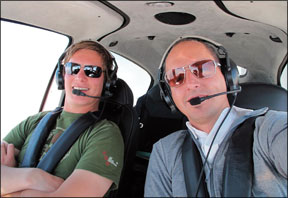
When composites hit the market, one selling point was that they wouldnt corrode, parts wouldnt break and they would be cheaper to maintain. This might have proved somewhat true, but whatever savings were lurking in the statistical noise got chewed up in higher avionics costs and, especially, database costs.
Its not that the avionics in the SR22 break more often than other aircraft, but there’s more of them and owners report that once off warranty, flat repairs run into dollars. Recurrent database and datalink weather subscription costs are also something owners of a decade ago didnt spend as much on. You get more with these systems, but you pay more to keep them up, too.
On the plus side, the IO-550 has proven to be a durable and economical engine. Were not seeing many complaints about soft cylinders or premature failures. We don’t see a widespread pattern of the engines not making TBO.
A scan of the FAAs Service Difficulty Reports revealed some complaints. Door fit and inadvertent opening is a problem in the early models. Cirrus addressed this with a redesign of the latch. Front wheel shimmy can be a problem. In one case, the wheel pant departed the airplane. A few other SDRs dealt with nosegear wear issues. There were also a handful of alternator and starter drive adapter failures. These are common in Continental engines and not unique to the Cirrus.
The SDRs revealed some avionics failures, but we suspect most of these arent reported. The boxes are simply shipped to the factory for repair, then returned to service.
The SR22 has a total of 14 airworthiness directives, a fair to middling score. None of these are especially onerous or expensive, but some do impact safety, such as 2008-14-13 which requires door hinge replacement to prevent the door from departing the airplane, 2008-06-28 which addresses significant PFD issues and 2007-14-03, which requires a modification of the CAPS activation system.
And speaking of CAPS, the earliest airplanes are now at the point of needing the 10-year repack/recertification. How much? Plan on about $12,500 all in, if you go with an overhauled unit, but close to $15,000 for a new one.
Market ScanBecause of the aforementioned habit of buyers to upgrade with each new model, Cirrus has been a victim of its own success. This became especially obvious in the fall of 2008 and spring of 2009 when a flood of SR22s of various vintages came on the market. At one point, we estimated as many as 200 might have been on the block. As of late 2010, the Cirrus Certified site shows about 50 used SR22s across a range of model years, but one broker told us the total is actually about 150.
Good deals? By all means. We think the best buys are the 2002 to 2004 aircraft with Avidyne avionics-particularly an early G2 model. The Bluebook lists these for under $200,000 retail and we don’t doubt bargains are out there. The 2001 to 2003 SR22s are even cheaper, with retail prices at a firesale $140,000. Some have the Avidyne Entegra, others steam gauges with an Avidyne MFD. The interiors on these first-generation SR22s was never a high point and many of these older SR22s have tired seats and carpets.
The Cirrus airplanes are exceptionally we’ll supported in our view, both by the factory and by one of the best owners groups around, the Cirrus Owners and Pilots Association at www.cirruspilots.org. For a detailed look at real-world performance numbers on Cirrus aircraft, see http://www.cirrusreports.com/.
We operate a Cirrus Aeroclub at Megara Aerodrome, in Greece, called Flight Experience (www.flightexperience.org ) where we have a 2004 SR22 and a 2007 SR22 Turbo. Both are G2s, with Avidyne, Garmin, de-icing and oxygen and are kept on the American registry. We use them to fly around the Greek islands, Turkey, Italy and beyond.
The cost of a 50-hour check is approximately 1000 Euros ($1300); the cost of a 100-hour check or annual is 2000 to 3000 Euros ($2600 to $3900). Our annual insurance is 4700 Euros ($6110). The main problems so far have been nosewheel shimmy, which got fixed but not immediately and an EGT false reading, which was fixed with the implementation of an optional Service Bulletin. There was also a one-off maintenance pipe fitting issue with the turbo and a slight problem with an oxygen malfunction. Both are now fixed.
We have been delighted with the qualities of the airplane (speed, comfort, visibility, avionics) and the problem is that now we can fly nothing less than a Cirrus.
Chris Leontopoulos
Flight Experience Aeroclub
Im part owner in a 2004 SR22-GTS and have owned shares of a couple other airplanes. Overall, Im quite happy with the airplane.
The number one pro is the avionics. In addition to the overall situational awareness, I have had cases where I maneuvered to avoid an aircraft solely based on the traffic warning and display. I have used the Stormscope to avoid thunderstorms when I was 25-50 miles away, and I regularly use the NEXRAD for long-range strategic planning. The METAR info is great for planning purposes, both for my destination airport and alternates.
I have not used the TAWS as much because I rarely fly in the mountains, however on IFR departures or night departures, Ill usually put the TAWS display up on the top Garmin GNS 430W (it came with the WAAS upgrade). Im glad that we did the WAAS upgrade. I have needed it for a few LPV approaches and I like how the autopilot will now track a hold.
Occasionally, the autopilot and the PFD don’t communicate at startup. If you don’t notice it on the ground, resetting the PFD in the air (by pulling the circuit breaker) fixes the problem. We get occasionally lose EMAX data when flying in the clouds. Were pretty sure this is due to P-static. Also, the Avidyne MFD can get overloaded with XM data, which causes the MFD to pause on screen changes and generates “Stormscope Heading Failure” messages.
I give the cockpit high marks overall. The visibility and the side joystick are terrific and its a comfortable ride. However, the environmental controls are a bit crude on the older model that we have. The plane is very responsive, but I use the autopilot on virtually all flights.
The door trim and rubber seals are a poor design. Passengers usually grab the rubber seals and pull them off as they are getting in. Also the doors require a lot of pressure to unlatch from the outside. Speaking of the doors, there is a lot of air noise on our model. The passenger door is tighter, so most of the noise is coming from the pilots door, which has been difficult to adjust.
We had a fair amount of issues early on with starter and alternator-two failures. But after we replaced these they lasted for over 1000 hours. Our plane has about 1940 hours on it, and we have replaced two exhaust valves on the number five cylinder and one exhaust valve on number three. The other cylinders still have decent compression.
Cirrus support used to be great but now its not so good. Its more difficult to get parts or to get a live person to talk to.
Alan Lukas
Portland, Maine

